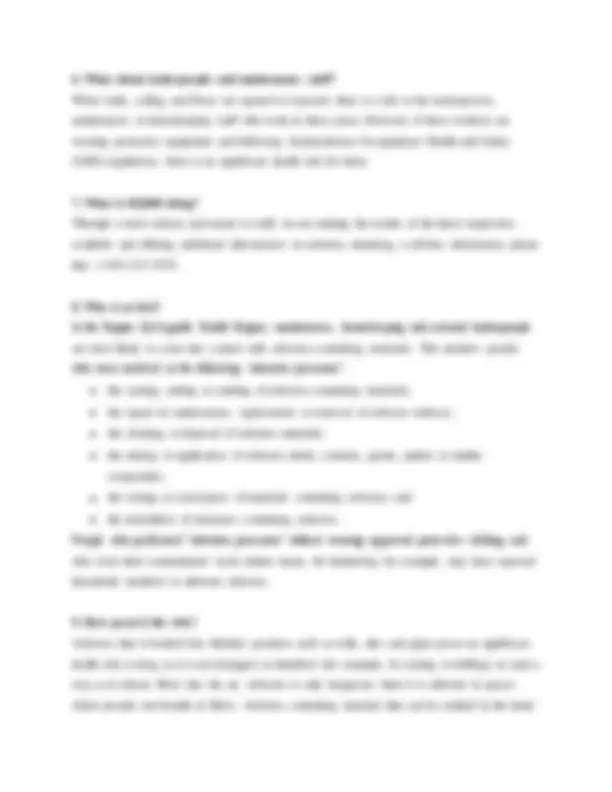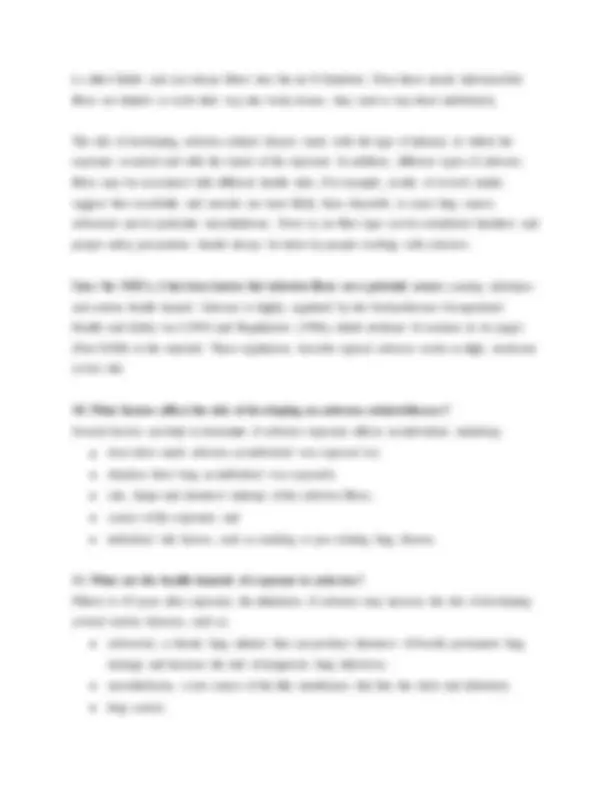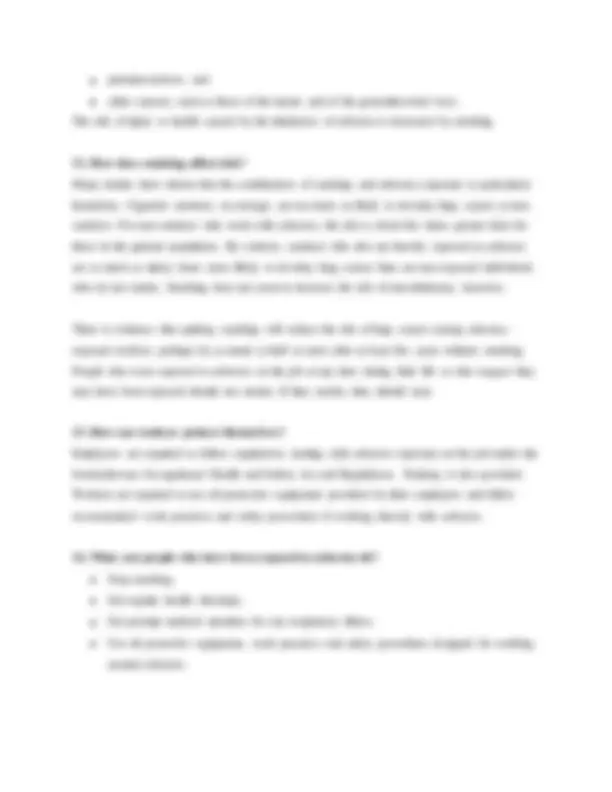






Study with the several resources on Docsity

Earn points by helping other students or get them with a premium plan


Prepare for your exams
Study with the several resources on Docsity

Earn points to download
Earn points by helping other students or get them with a premium plan
Community
Ask the community for help and clear up your study doubts
Discover the best universities in your country according to Docsity users
Free resources
Download our free guides on studying techniques, anxiety management strategies, and thesis advice from Docsity tutors
An in-depth look into asbestos, its types, uses, health hazards, and commonly asked questions. Asbestos is a naturally occurring mineral known for its strength and flexibility, making it widely used in various industries. However, its fibers can be harmful when inhaled, leading to serious health issues such as asbestosis, mesothelioma, and lung cancer. the four main types of asbestos, their applications, and the risks associated with them. It also discusses the health hazards of asbestos exposure, including the diseases it can cause and the factors that increase the risk of injury. Additionally, it provides information on how to identify and manage asbestos in buildings and workplaces, as well as the regulations governing asbestos exposure.
Typology: Exams
1 / 8

This page cannot be seen from the preview
Don't miss anything!





Asbestos: Common Questions and Answers
1. What is asbestos? Asbestos is the name given to a group of minerals that occur naturally as masses of strong, flexible fibres that can be separated into thin threads and woven threads. These fibres are not affected by heat or chemicals and do not conduct electricity. For these reasons, asbestos has been widely used in many industries. Four types of asbestos have been commonly used:
chrysolite, or white asbestos (curly, flexible white fibres), which accounts for about 90 per cent of the asbestos being used in the industry; amosite (straight, brittle fibres that are light grey to pale brown in color); crocidolite, or blue asbestos (straight blue fibres); and anthrophyllite (brittle white fibres).
2. How is asbestos used? Asbestos has been mined and used commercially in North America since the late 1800s, but its use increased greatly during World War II. Since then, it has been used in many industries. For example, the building and shipbuilding industry uses it for strengthening cement and plastics as well as for insulation, fireproofing and sound absorption. The shipbuilding industry has used asbestos to insulate boilers, steam pipes, hot water pipes and nuclear reactors in ships. The automotive industry uses asbestos in vehicle brake shoes and clutch pads. More than 5, products contain or have contained asbestos, some of which are:
asbestos cement sheet and pipe products used for water supply and sewage piping, roofing and siding; casings for electrical wires, fire protection material, chemical tanks, electrical switchboards and components; residential and industrial building materials; friction products, such as clutch facings, brake linings for automobiles, railroad cars, airplanes and industrial friction material;
products containing asbestos paper such as table pads and heat-protective mats, heat and electrical wire insulation, industrial filters for beverages, small appliance components and underlying material for sheet flooring; asbestos textile products, such as packing components, roofing materials, heat and fire resistant clothing, fireproof draperies; and other products including ceiling and floor tile, gaskets and packing, paints, coatings, sealants, caulking tape, patching tape and plastics.
In the late 1970’s, the US Consumer Product Safety Commission banned the use of asbestos in wallboard patching compounds and gas fireplaces because these products released excessive amounts of asbestos fibres into the environment. In addition, asbestos was voluntarily withdrawn by manufacturers of electric hair dryers.
3. Why is the Regina Qu’Appelle Health Region (RQHR) taking this action? In 2010, RQHR and its Affiliates commissioned industry asbestos experts to do an audit of all health facilities in the region which may have asbestos to ensure complete and consistent documentation. Friable asbestos which is exposed and may become airborne, can be a health risk. RQHR wanted to be proactive and comprehensive in ensuring safety. 4. What did the audit find? The audit found some facilities that had friable asbestos in a condition with a potential to become airborne, if disturbed. Friable asbestos in this condition has been removed or contained. 5. Is there any risk to the public, patients or families of being exposed to friable asbestos? There is no substantial health risk to this. Almost all asbestos is contained within walls, ceilings and floors and presents no significant health risk. Friable asbestos found in poor condition was not located in public or patient areas.
is called friable and can release fibres into the air if disturbed. Once these nearly indestructible fibres are inhaled or work their way into body tissues, they tend to stay there indefinitely.
The risk of developing asbestos-related disease varies with the type of industry in which the exposure occurred and with the extent of the exposure. In addition, different types of asbestos fibres may be associated with different health risks. For example, results of several studies suggest that crocidolite and amosite are more likely than chrysotile to cause lung cancer, asbestosis and in particular mesothelioma. Even so, no fibre type can be considered harmless and proper safety precautions should always be taken by people working with asbestos.
Since the 1960’s, it has been known that asbestos fibres are a potential cancer-causing substance and serious health hazard. Asbestos is highly regulated by the Saskatchewan Occupational Health and Safety Act (1993) and Regulations (1996), which dedicate 16 sections in six pages (Part XXIII) to the material. These regulations describe typical asbestos works as high, moderate or low risk.
10. What factors affect the risk of developing an asbestos-related disease? Several factors can help to determine if asbestos exposure affects an individual, including: dose (how much asbestos an individual was exposed to); duration (how long an individual was exposed); size, shape and chemical makeup of the asbestos fibres; source of the exposure; and individual risk factors, such as smoking or pre-existing lung disease. 11. What are the health hazards of exposure to asbestos? Fifteen to 45 years after exposure, the inhalation of asbestos may increase the risk of developing several serious diseases, such as: asbestosis, a chronic lung ailment that can produce shortness of breath, permanent lung damage and increase the risk of dangerous lung infections; mesothelioma, a rare cancer of the thin membranes that line the chest and abdomen; lung cancer;
pneumoconiosis; and other cancers, such as those of the larynx and of the gastrointestinal tract. The risk of injury to health caused by the inhalation of asbestos is increased by smoking.
12. How does smoking affect risk? Many studies have shown that the combination of smoking and asbestos exposure is particularly hazardous. Cigarette smokers, on average, are ten times as likely to develop lung cancer as non- smokers. For non-smokers who work with asbestos, the risk is about five times greater than for those in the general population. By contrast, smokers who also are heavily exposed to asbestos are as much as ninety times more likely to develop lung cancer than are non-exposed individuals who do not smoke. Smoking does not seem to increase the risk of mesothelioma, however.
There is evidence that quitting smoking will reduce the risk of lung cancer among asbestos- exposed workers, perhaps by as much as half or more after at least five years without smoking. People who were exposed to asbestos on the job at any time during their life or who suspect they may have been exposed should not smoke. If they smoke, they should stop.
13. How can workers protect themselves? Employers are required to follow regulations dealing with asbestos exposure on the job under the Saskatchewan Occupational Health and Safety Act and Regulations. Training is also provided. Workers are required to use all protective equipment provided by their employers and follow recommended work practices and safety procedures if working directly with asbestos. 14. What can people who have been exposed to asbestos do? Stop smoking. Get regular health checkups. Get prompt medical attention for any respiratory illness. Use all protective equipment, work practices and safety procedures designed for working around asbestos.
19. How is the Regina Qu’Appelle Health Region identifying and prioritizing the safe removal/containment of asbestos-containing materials? RQHR is following OHS regulations in identifying and containing asbestos. All friable asbestos with the potential to become airborne has now been removed or contained by qualified contractors. Those areas still containing friable asbestos will be monitored and will undergo an annual inspection. 20. If the audit report was done in 2010, why are we being notified now?
After the report was received, our first priority was to develop a plan to remove or contain any friable asbestos, which posed a potential hazard in a safe, timely manner. Staff members at affected facilities were also informed at that time. We also consulted with a number of internal and external experts to develop a strategy for ongoing management.
21. Do I need asbestos safety training? Only staff required to work with asbestos containing materials require asbestos process training. General awareness training is available to all staff and has been provided at facilities prior to remediation. 22. Is there an RQHR/Affiliate policy and procedure for managing and working with asbestos containing materials? We are currently developing a policy and procedure for working with asbestos-containing materials, which forms part of our ongoing asbestos management program. Affiliate health facilities are part of this process. 23. How do I know if I have been exposed to asbestos at work? If you performed an ‘asbestos process’ (see question 8) in an area where you suspect there were asbestos-containing materials, without the use of personal protective equipment, you may have had an exposure to asbestos.
24. What do I need to do if I think I may have been exposed to asbestos, while working for the RQHR or one of its Affiliates? Please contact the toll-free line we have established: 1-855-215-5553 and follow the prompts.